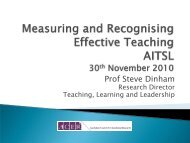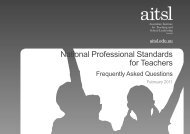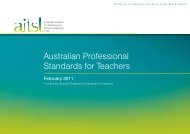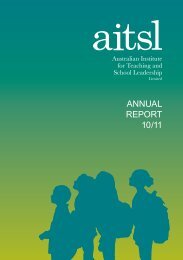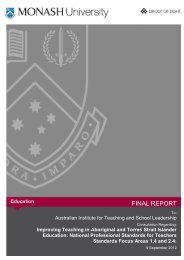ReferencesAinscow, M. (2005). Developing inclusive education systems: What are the levers for change? Journalof Educational <strong>Change</strong>, 6, 109-124.Alliance for Excellent Education (2010). Policy Brief: Principles for a Comprehensive AssessmentSystem. Washington DC: Alliance for Excellent Education.Anderson, L. (2004). Increasing teacher effectiveness (Second Edition ed.). Paris: UNESCOInternational Institute for Educational Planning.Anderson, R. D. (1996). Study of <strong>Curriculum</strong> Reform. Volume I: Findings and Conclusions. Studies ofEducational Reform. (ERIC Document Reproduction Service No. ED 397535)Anthes, K. (2005). Leader Standards. ECS Highlights. Denver: Education Commission of the States.Archer, M. (1988). Culture and agency: The place of culture in social theory. Cambridge: CambridgeUniversity Press.Archer, M. (1995). Realist social theory: The morphogenetic approach. Cambridge: CambridgeUniversity Press.Archer, M. (2000). Being human: The problem of agency. Cambridge: Cambridge University Press.Australian <strong>Curriculum</strong>, Assessment and Reporting Authority (ACARA) (2010). The Shape of theAustralian <strong>Curriculum</strong>. Version 2.0. Sydney: ACARA.Avolio, B. J., Walumbwa, F. O., and Weber, T. J. (2009). Leadership: Current Theories, Research, andFuture Directions. Annual Review of Psychology, 60(1), 421-449.Bain, A. (2007). The Self-organizing School: Next Generation Comprehensive School Reforms. Lanham,MD: Rowman and Littlefield.Baines, E., Blatchford, P., and Chowne, A. (2007). Improving the effectiveness of collaborative groupwork in primary schools: effects on science attainment. British Educational Research Journal, 33(5), 663- 680.Barab, S. A., MaKinster, J. G., and Scheckler, R. (2003). Designing System Dualities: Characterizinga Web-Supported <strong>Professional</strong> Development Community. The Information Society: An InternationalJournal, 19(3), 237 - 256.Bays, D. A., & Crockett, J. B. (2007). Investigating instructional leadership for special education.Exceptionality: A Special Education Journal, 15(3), 143 - 161.Beavers, A. (2009). Teachers as learners: Implications of adult education for professional development.Journal of College Teaching and <strong>Learning</strong>, 6(7), 25-30.Bennett, N., Newton, W., Wise, C., Woods, P., and Economou, A. (2003). The Role and Purpose ofMiddle Leaders in Schools: Summary Report. Nottingham: National College for School Leadership.Bennett, N., Wise, C., and Woods, P. (2003). Distributed Leadership. Nottingham: National College forSchool Leadership.Bolam, R., McMahon, A., Stoll, L., Thomas, S., and Wallace, M. (2005). Creating and SustainingEffective <strong>Professional</strong> <strong>Learning</strong> Communities. Bristol: Department for Education and Skills.Boyle, W. F., and Charles, M. (2010).<strong>Leading</strong> learning through Assessment for <strong>Learning</strong>? SchoolLeadership and Management: Formerly School Organisation, 30(3), 285 - 300.Brewster, C., and Railsback, J. (2003). Building Trusting Relationships for School Improvement:Implications for principals and teachers. Portland: Northwest Regional Educational Laboratory.35 <strong>Professional</strong> <strong>Learning</strong> <strong>Flagship</strong> <strong>Program</strong>: <strong>Leading</strong> <strong>Curriculum</strong> <strong>Change</strong>: Literature Review
Bridges, E. (1977). The nature of leadership. In L. Cunningham, W. Hack and R. Nystrand (eds.),Educational Administration: The developing decades. Berkeley: McCutchan.Brown, K. (2006).Leadership for Social Justice and Equity: Evaluating a Transformative Framework andAndragogy. Educational Administration Quarterly, 42(5), 700-745.Brundrett, M., and Rhodes, C. (2010). Leadership for Quality and Accountability in Education. FlorenceKY: Routledge.Bryk, A., and Schneider, B. (2002). Trust in schools: A core resource for improvement. New York:Russell Sage Foundation.Bubb, S., and Earley, P. (2008). From self-evaluation to school improvement: the importance of effectivestaff development. Reading: CfBT Education Trust.Burchill, M., Higgins, D., Ramsamy, L., and Taylor, S. (2006). Working’ together: Indigenousperspectives on community development. Family Matters, 75, 50-59.Bush, T. (2003). Theories of educational leadership and management. London: Sage Publications.Busher, H., and Harris, A. (1999). Leadership of School Subject Areas: Tensions and dimensions ofmanaging in the middle. School Leadership and Management: Formerly School Organisation, 19(3), 305- 317.Capper, C., Theoharis, G. and Sebastian, J. (2006). Toward a framework for preparing leaders for socialjustice. Journal of Educational Administration, 44(3), 209-224.Carroll, T., Fulton, K., and Doerr, H. (2010). Team Up for 21st Century Teaching and <strong>Learning</strong>: Whatresearch and practice reveal about professional learning. Condensed excerpts. Washington DC:National Commission on Teaching and America’s Future.Castagno, A. and Brayboy, B. (2008).Culturally Responsive Schooling for Indigenous Youth: A Review ofthe Literature. Review of Educational Research, 78(4), 941–993.Center for Strengthening the Teaching Profession (2009). Teacher Leaderships Skills Framework.Tacoma.Centre for Educational Research and Innovation (1998). Making the <strong>Curriculum</strong> Work. Paris:Organisation for Economic Co-operation and Development.Cohen, D. K., and Ball, D. L. (1990). Relations between policy and practice: A commentary. EducationalEvaluation and Policy Analysis, 12(3), 331-338.Colbert, J., Brown, R., Choi, S., and Thomas, S. (2008). An Investigation of the Impacts of Teacher-Driven <strong>Professional</strong> Development on Pedagogy and Student <strong>Learning</strong>. Teacher Education Quarterly, 35,135-154.Cordingley, P., Bell, M., Thomason, S., and Firth, A. (2005). The impact of collaborative continuingprofessional development (CPD) on classroom teaching and learning. Review: How do collaborative andsustained CPD and sustained but not collaborative CPD affect teaching and learning? . London: EPPI-Centre, Social Science Research Unit, Institute of Education, University of London.Cosner, S. (2009). Building organizational capacity through trust. Educational Administration Quarterly,45(2), 248-291.Crowther, F., Hann, L. and McMaster, J. (2001). Parallel leadership: A new strategy for successful schoolreform, The Practising Administrator, 23(4), 12-14.Crowther, F., Kaagan, S., Ferguson, M. and Hann, L.(2002). Developing Teacher Leaders: How teacherleadership enhances school success. Thousand Oaks: Corwin Press.Cuban, L. (1998). How schools change reforms: Redefining reform success and failure. TeachersCollege Record, 99(3), 453–477.<strong>Professional</strong> <strong>Learning</strong> <strong>Flagship</strong> <strong>Program</strong>: <strong>Leading</strong> <strong>Curriculum</strong> <strong>Change</strong>: Literature Review 36
- Page 1 and 2: Professional Learning FlagshipProgr
- Page 3 and 4: ContentsIntroduction ..............
- Page 5 and 6: Curriculum change: Implications for
- Page 7 and 8: Table 1: Overview of factors affect
- Page 9 and 10: This emphasis on capacity-building
- Page 11 and 12: Much of the foregoing discussion is
- Page 13 and 14: Features of successful professional
- Page 16 and 17: p. 1051) conclude that, ‘Findings
- Page 18 and 19: 2007; Gruenert 2005; Printy 2008; S
- Page 20 and 21: RecommendationsProfessional learnin
- Page 22 and 23: impersonal relationships• rationa
- Page 24 and 25: • The organisational goals are di
- Page 26 and 27: Table 2: Two views of teacher leade
- Page 28 and 29: A range of specifications and stand
- Page 30 and 31: In secondary schools, teacher leade
- Page 32 and 33: 1. Stimulus for innovation — Why
- Page 34 and 35: Table 4: Elements and processes of
- Page 36 and 37: The education of Indigenous student
- Page 40 and 41: Daly, A. J. (2009). Rigid Response
- Page 42 and 43: Hall, R. (1997). Knowledge Use and
- Page 44 and 45: Meirink, J., Meijer, P., Verloop, N
- Page 46 and 47: Thorpe, R., and Gold, J. (2010). Le
- Page 48: aitsl.edu.auFurther informationTele





